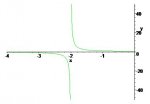Hi im new to this forum and i desperately need help. Anyways, I have 7 problems that i need help with and i would really appreciate it if you could give a step-by-step solution. And its okay if you can only answer one of them and not all of them. Thanks.
1. F(x)=(1/x+1) and G(x)=x^2-5. Find values of discontinuity for F(G(x))
2. Find value of c so continuity exists when F(x)= x+3, x =<(less than or equal) to -1 and 2x-c, x > -1
3. F(x)=5/x-1, G(x)=x^4 Find F(G(x)) and find value of discontinuity
4. Lim h=>0 of Sqrt(x+h)-8 - sqrt(x-8)/h
5. Use Squeeze theorem to find Lim x=>a of F(x) when B-(x-a)=< (less than or equal) F(x) =< (less than or equal) B+(x-a)
6. x-2/x^2-4. Find discontinuity and either if its removable or nonremovable.
7. Graph F(x)= Double absolute (x-4) and find continuity and everything else related to this subject. I forgot what exactly the question asked but i think its this.
1. F(x)=(1/x+1) and G(x)=x^2-5. Find values of discontinuity for F(G(x))
2. Find value of c so continuity exists when F(x)= x+3, x =<(less than or equal) to -1 and 2x-c, x > -1
3. F(x)=5/x-1, G(x)=x^4 Find F(G(x)) and find value of discontinuity
4. Lim h=>0 of Sqrt(x+h)-8 - sqrt(x-8)/h
5. Use Squeeze theorem to find Lim x=>a of F(x) when B-(x-a)=< (less than or equal) F(x) =< (less than or equal) B+(x-a)
6. x-2/x^2-4. Find discontinuity and either if its removable or nonremovable.
7. Graph F(x)= Double absolute (x-4) and find continuity and everything else related to this subject. I forgot what exactly the question asked but i think its this.


